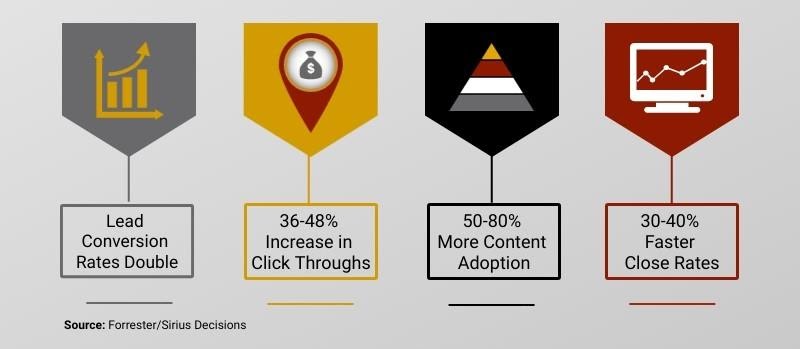This post is contributed by Gordana Stok, a Certified Practitioner of the Buyer Persona Institute methodology.
Last year I decided to learn how to develop buyer personas so that I could become a better content marketer. Having practiced the craft of content marketing for over a decade, I was no stranger at producing content that helps buyers to make a more informed and educated purchasing decision. And, until a year ago, I honestly thought that I was communicating value from the buyer’s perspective.
But when the value proposition that I had helped to create for one of my B2B clients was canned by their new VP of Sales and Marketing, I started to question the very process marketers use and the people who get involved. It wasn’t until I came across an ebook from Buyer Persona Institute that I truly understood the problem.
Like many marketing teams, we had reverse-engineered the product’s value based on its top features and unique selling points – not necessarily on what’s most important to buyers. So when the new VP challenged our value proposition, we couldn’t back up any of our claims with hard data. It became one person’s opinion versus another’s. And guess whose opinion won?
With the term “reverse-engineering” ringing loudly in my ears, I signed up for the Buyer Persona Institute Masterclass and became a Certified Practitioner of the 5 Rings of Buying Insight™ methodology. Having now worked on buyer personas for several companies and interviewed dozens of decision-makers, here are the six most important and surprising things that I have learned so far.
 1. You need to win both the hearts and minds of buyers – even in a complex B2B sale.
1. You need to win both the hearts and minds of buyers – even in a complex B2B sale.
The first thing that surprised me is just how willing and eager buyers are to reveal details about their buying journey around a specific product – especially when there was a lot at stake for them and their organization. When asked the right questions, buyers will share both the cold hard facts and requirements that shaped their purchasing decision, as well as the doubts, fears, relief, confidence and joy they experienced as they went from status quo to successful implementation. When you hear senior business executives at multi-billion dollar organizations express such strong emotion, you realize you need to do more than just appeal to their intellect. You need to win both their hearts and minds.
2. You can capture a wealth of actionable insights conducting 30-minutes interviews with just 10 buyers.
I’m always amazed when I review the transcripts from the recorded interviews with buyers and I first bring all the quotes into Excel to analyze the data. Conducting 30-minute interviews with just 10 buyers can easily generate over 350 revealing quotes! The key, of course, is to carefully interpret each one, identify the most significant trends and select the strongest quotes to include in the final buyer persona. An art unto itself! The quotes that make the cut are those that provide new or thought provoking insights as well as enough details so that a clear plan of action can be taken. So unlike the “buyer personas” that are created based on generic, demographic data, the insights from interview-based personas provide a real competitive advantage.
3. Only a fraction of what’s important to buyers is typically addressed on a company’s website.
It goes without saying that when you hear buyers express their pain points and needs in their own words, along with the criteria they use to evaluate solution options and make their final purchasing decision, it becomes crystal clear what information they need and how to message them. What I’m repeatedly surprised by, however, is just how far off-course a company’s content can be without these insights. In my experience, only 20% to 40% of what buyers consider to be important is actually addressed on a company’s website. The good news for marketers is that buyer quotes can easily be turned into benefit statements and inspire topics for numerous content marketing pieces. As the President of Buyer Persona Institute, Adele Revella, likes to say, “The content practically writes itself”.
4. Buyers want more in-depth product information so the length of content isn’t as important as relevance and clarity.
Being a content marketer at heart who loves to build understanding and influence people’s views, this is one of my favorite findings from interviewing buyers. When researching solution options, buyers quickly scan a company’s website to determine whether it has a solution worth investigating, so content needs to be brief. But when buyers are seriously considering a solution, they want in-depth case studies, white papers and technical briefs that enable them to assess whether the solution will work in their environment and generate the expected results. Length of content during this phase in the buying journey is not as important as relevance and clarity. What’s more, you can’t possibly create a persuasive argument for purchasing your solution if your argument has holes or isn’t backed by credible data. So go ahead and increase the word count to make sure you’re not disqualified due to insufficient information or a weak argument.
5. Buyers want companies to make it easier for them to evaluate and compare competitive solution options and demonstrate ROI.
One of the questions that I love to ask buyers during interviews is “How could the companies that you considered have made the buying experience easier for you?” The top two responses from buyers, regardless of the product category, industry, size of the buyer’s organization or the buyer’s title, are “Make it easier for me to evaluate and compare competitive solution options” and “Help me to demonstrate the ROI to my executive team”.
The most common complaint buyers have is that it’s difficult to compare solution options because every company uses a different marketing term to mean the same thing. It’s like comparing apples to oranges. Buyers want a company’s website to include a chart that compares their solution’s features with the competition’s using more neutral terms. Buyers realize that the chart will be skewed in favor of the company’s solution, but they still feel it’s a good starting point for evaluating solutions.
Furthermore, buyers need to demonstrate return on investment to their executive team in order to get final sign-off, so any information or tools that a company can provide is extremely helpful. This includes industry research reports that demonstrate the impact the solution category has on an organization’s business and ROI figures tailored specifically for their organization.
6. After experiencing the power of interview-based, buyer personas first-hand, I can’t imagine doing content marketing without it.
This may sound like an exaggeration, but I honestly don’t know how I managed to do content marketing effectively without buyer personas. My perspective has completely changed and I hope to never have to go back to guessing what messages will resonate with buyers or relying solely on the opinions of internal stakeholders. I realize that not all companies may be ready or willing to embark on a buyer persona project for a variety of reasons. But when I work with clients nowadays, my advice to them is this: You can’t know with absolute certainty what’s important to buyers and what information you need to persuade them to purchase your solution until you ask them.





